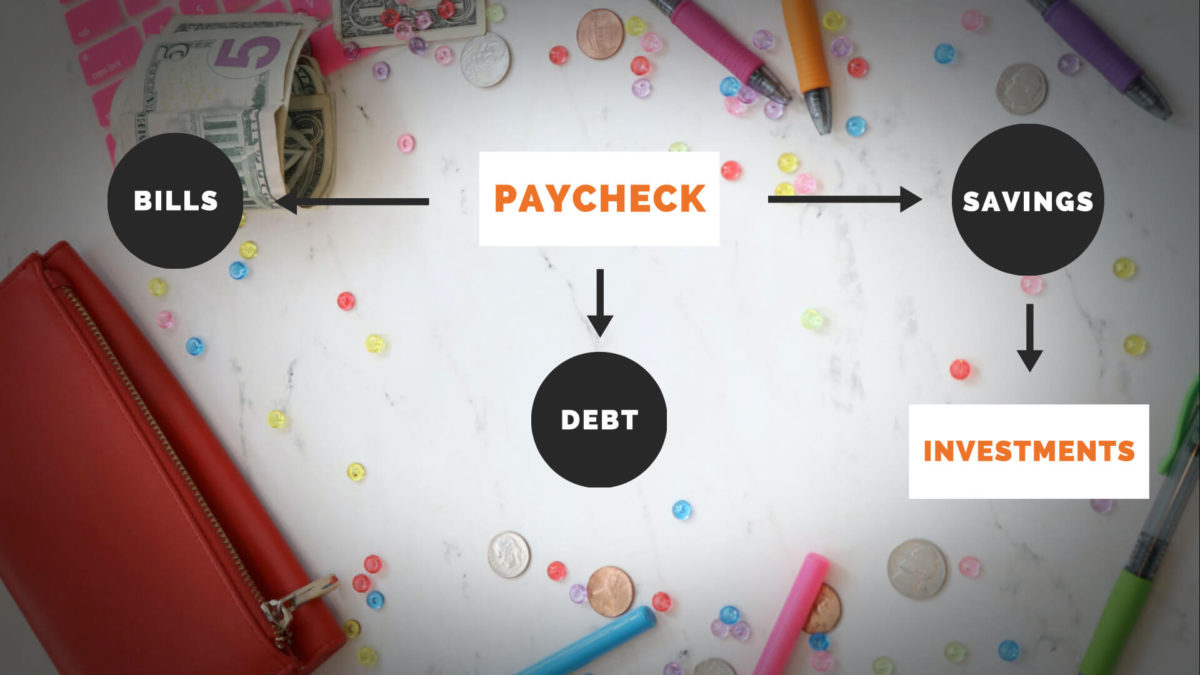One day, a long time ago, I woke up and realized that I was in trouble. I accumulated a lot of student debt, I hardly had any savings, and I did not have the slightest clue about investments. All of my financial accounts were manually managed. I worked through each transfer one at a time. I hadn’t learned how to automate my personal finances, I was still in the first working on my first step to financial freedom. I’ll explain how to automate your finances and savings in five steps as I did!
I just accepted my first pharmacy job and needed to figure out the best way to manage more income than I had ever had before.
Which of my financial inefficiencies should I address first?
I knew I wanted to be debt-free, start saving, and eventually learn how to invest. This would take a lot of time and I needed to plan ahead and figure out which financial need to take care of first. There were a lot of questions I needed to answer to get where I wanted to be.
It all felt so overwhelming but I knew I just needed to start somewhere. I needed to set up a system to automate my finances.
Where does all my money go?
Tracking Spending
Knowing how your money is spent should be the first step you take towards automating your finances. I wanted to be able to track where each dollar was spent. My bank accounts and credit cards were already linked with Mint.com but I wasn’t reviewing the data on a regular basis.
If you’re unfamiliar with Mint.com, it is a budgeting service that will try to categorize your expenses and income automatically. It is a great tool to track your spending and to understand your finances. It’ll help you build your own FIRE budget. It will do its best to correctly categorize each line item but it is best to review it weekly to monitor the categorization and ensure it is correct.
Once I got in the habit of reviewing my Mint data weekly, I could easily see how much money I was spending in any category. I could spot unnecessary expenses like coffee-to-go or ATM fees.
Student Loan Payments
The biggest thing weighing on my head was my large accumulation of student loans—$132,774, not to mention the interest!
I’d just taken a trip to the Dominican Republic to celebrate my graduation and hardly had any money left in savings. Since my student loans would be in deferment for another 6 months, I decided it would be best to start by building up my savings. The deferment meant I wouldn’t be paying interest on my loans just yet.
Like most people, I thought saving any money would be impossible. For me to understand where my money was going and if any would be leftover at the end of the month, I needed to see numbers on paper. Well in my case, a digital spreadsheet. Now I needed to figure out where to get the data to put in that spreadsheet.
Digital Spending Data
I was using credit cards for most of my spending but I never held a balance. I would not spend more than I could pay off in a month. However, by mainly using credit cards, tracking expenses with Mint was super easy. When I eventually got around to recreating my budget, this tool was key to reviewing my historical spending.
But for now, I just wanted to know how much my average spending was per month. With a few clicks of the mouse, I ran a trend report and came up with the value of my average expenses.
I was moving to a bigger apartment without a roommate, so my rent would also be going up. I wanted to account for this so I added in the additional rent and bill expenses. From there, I would need to subtract these expenses from a new salary. Whatever was leftover would be the start of my savings.
Automate Your Finances: Create a Personal Finance System
Doing the math and seeing that it was possible, really gave me some hope. By using my simple spreadsheet method, I was able to calculate the excess funds that I would feel comfortable putting towards my saving.
I set up automatic transfers to move that excess to my high-interest savings account. And once my loan payments started up, I could just plug the data in and crunch some numbers to see how much additional I could pay towards my loans, while maintaining my savings. I set all payments up on automatic withdraw so I would never miss the excess funds.
I created a method to automate my personal finances and I was able to pay off my student loans in less than 5 years. That let me start building my nest egg to eventually reach FIRE and switch from full-time to part-time work.
5 Steps to Automating Your Finances & Savings
In the future, my plan is to write about my FIRE story and the steps that I took to be able to start saving, zero out my student loan debt, and become an investor.
Let’s start the process of automating your finances by building a savings fund.
1) Track and categorize your expenses
As I mentioned before, Mint is a great tool if you mostly spend on credit but don’t forget to track and categorize any cash spending.
If you are a 100% cash person and have no way of calculating your historical spending, you can start with your known expenses like rent, insurance, and utility bills. Then, start tracking every dollar you spend for the next month. Check out Dave Ramsey’s envelope budgeting method, or just keep a ledger of your expenses. This will also help down the road when I get into how to reduce spending and create a healthy budget.
Since I use credit cards I lumped the data together into two categories: rent/utility bills and credit card payments. In our example situation, average spending on these two categories was $1,700 (you’ll see this spending in the example spreadsheet below).
2) Determine the amount of your ideal savings account balance
Your savings account should be a place you use to work toward your longterm money goals. For example, you might save money in order to:
- Put a downpayment on a house
- Have a wedding
- Buy a new car
- Build an emergency fund
My primary goal was to build an emergency fund. I wanted to have money set aside in case something happened like I lost my job or a major medical expense came up.
An easy way to calculate an appropriate emergency fund is to multiply your average monthly budget by 6. This would give you 6 months of funds to live off of in an emergency.
However, you may be just starting to work on reducing your spending and improving your finances. Your average monthly spending is probably a lot more than you may need to spend to just ‘survive’ in an emergency. In this case, focus on keeping just enough money to cover the essential categories:
- Housing
- Utilities
- Health insurance
- Gas
- Groceries
My ideal emergency fund was $10,200 and just $8,000 for the “bare essentials”. As I was keeping my emergency fund in my savings account, this formed the basis for my savings account goal.
3) Track your income
You need to know how much money will be coming in and when. Include your paychecks and any other expected bonuses.
Be sure you know how frequently you are paid:
- Every 2 weeks (26 paychecks)
- Twice a month (24 paychecks)
- Monthly (12 paychecks)
This will be important when setting up automatic payments and transfers while maintaining your monthly account balances. I would be getting a paycheck of $1,400 every 2 weeks.
4) Create an expense/income report to track changes over time
I created my report to reflect monthly expenses and income in the order in which they would be used throughout the month.
| Month | Description | $ IN | $ OUT | Checking Balance | $ IN | $ OUT | Saving Balance | Total |
|---|---|---|---|---|---|---|---|---|
| June | $2,000 | $4,500 | $6,500 | |||||
| Bill/Rent | $1,000 | $1,000 | $4,500 | $5,500 | ||||
| Payday | $1,400 | $2,400 | $4,500 | $6,900 | ||||
| $ to Save/Invest | $1,100 | $1,300 | $1,100 | $5,600, | $6,900 | |||
| CC Payment | $700 | $600 | $5,600 | $6,200 | ||||
| Payday | $1,400 | $2,000 | $5,600 | $7,600 | ||||
| Extra to Save | $2,000 | $5,600 | $7,600 |
I started with rent since is it was due on the 1st of each month followed by my first biweekly paycheck, credit card payments, 2nd paycheck, etc. All of my bills were set up for automatic withdrawal.
It was very important that I knew when each payment would be taken out versus when my paycheck would be deposited. Having it laid out like this on a spreadsheet let me see that I would not overdraw my accounts. You can make your own version of this report by using this Google Sheet, too!
In the table example above, my checking balance would drop to $600 (bold on the 5th row of the 5th column). However, it would quickly recover with my next payday.
I repeated the table every month and added in extra expenses like Christmas or vacations. I also added an extra line for any extra income to boost my savings if I felt I had a little extra to put away.
5) Set the amount you want to save monthly
I started with the amount of money in the savings account that would allow me to have bills on automatic payments without going into a negative balance. I didn’t want to add more money to my low-interest checking account. Instead, I chose to move all of my extra funds into my high-interest savings account.
To calculate how much I needed to save each month, I simply subtracted my expenses from my income: $2,800-$1,700 = $1,100. Every month, I would be $1,100 closer to meeting my emergency fund goal.
You should try starting with 10% of your income and plug it into the spreadsheet. Month after month, you will be able to see your account balance grow and also know that your account balance will not be overdrawn.
Benefits of Automating Your Finances
This exercise really helped me develop a habit of tracking my spending and setting money aside for savings.
- Identify the maximum safe amount that you can transfer monthly to savings
- Automate transfers between your accounts to save time
- Periodically reevaluate your tracked values to determine if you can increase (or need to decrease) your saving amounts
Part of my learning process was to follow standard personal finance advice about how to live below your means. I was able to quickly reach my emergency fund goal. Now that my personal finances were automated, I could start working on my next financial need: how to tackle my student loans. I hope my example serves as a template for you to automate your finances.
I will cover debt and student loans soon, so stay tuned!
What ways have you found to be useful to maximize your savings while preventing overdrafts and automate your finances?

